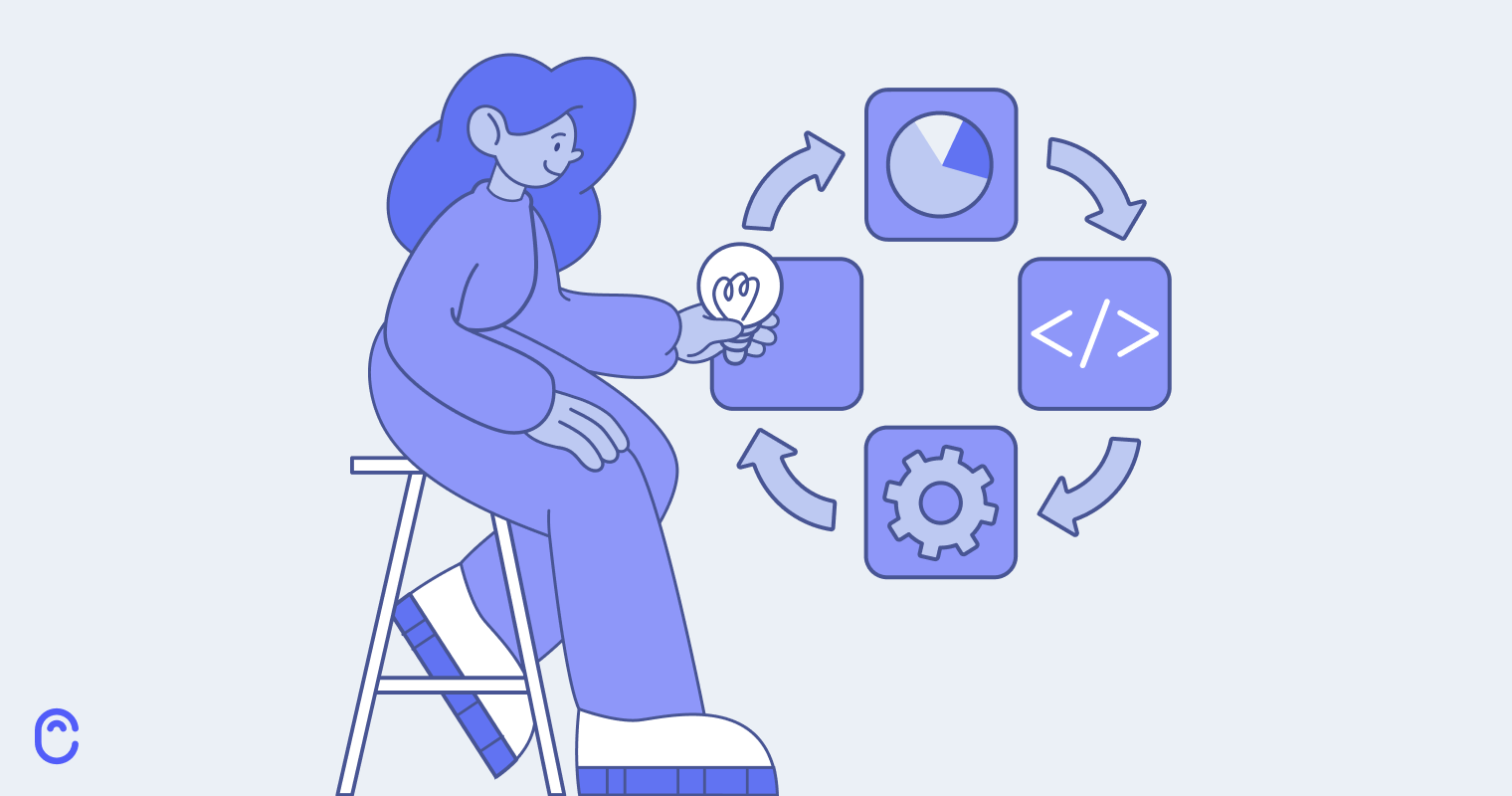Product management is a relatively new field. It originated in the 1930s and was a part of marketing. Neil McElroy from Procter & Gamble wrote a famous company-wide memo about brand management principles, which incorporated the tasks of a product manager.
In just under 100 years, product management has seen many changes. It’s become increasingly more technical. Today, some PMs work closer with engineers than with marketing, and many need to know basic coding.
Technology, business, and the product world will always evolve. Your users, competitors, and the industry will also change. To stay competitive and relevant, you need to innovate.
There are many tried-and-true PM tactics that can help you drive innovation. But, we want to encourage you to look beyond them.
We asked 18 product leaders to share unconventional product management strategies they use. Let’s explore their ideas and insights in this blog post.
Why do we need new and unconventional approaches?
First of all, “if it’s not broken, don’t fix it.” There are many outstanding and sound product management frameworks out there. You don’t have to change just for the sake of changing.
Still, remember that things around you will always evolve.
Many experts discuss how AI is changing product management. Some worry that AI will replace PMs, while others are excited about AI helping them uncover powerful insights.
“The integration of AI into product management has been nothing short of transformative. An advanced AI algorithm can sift through vast datasets and decipher intricate customer behavior and preferences.”
Kamil Rejent, CEO at Survicate
The bottom line: you need to adapt.
The good news: you can use frameworks that serve you well and still explore new ideas. You don’t have to abandon your tried-and-tested methods, especially if they deliver results. At the same time, we encourage you to challenge the status quo (even a little bit). Who knows – maybe you’ll find the next big breakthrough in these unconventional tactics.
As you discover new frameworks, keep this in mind.
“It’s not about the framework itself. It’s about fixing the right problems in our process. It’s easy to get caught up in the latest, shiny new framework. But it is important to stay focused on what needs improving in our own backyard.
So, whether it’s a traditional framework or an unconventional approach, the key is to pick what works best for our unique challenges.”
Elisa Montanari, head of organic growth and website strategy at Wrike
Potential issues with popular frameworks
Many traditional frameworks work really well. Our clients, partners, and even our team use them! Here’s how we prioritize feature requests, for example (using weighted scoring).
However, we know that “what got us here won’t get us there” (to the next stage of our business). So we keep using what’s working but always look for new and interesting ideas. We also try to apply strategic thinking and critically assess how we’ve done things so far.
“Some businesses or people get ‘stuck in the mud’ regarding how things are done. When they resist changing processes and ways of thinking, they rarely meet their full potential.”
Clare Garrity, operations at Canny
Well-known product management frameworks are popular for a reason. But they do have some drawbacks.
Here are some potential issues with conventional approaches to product management. They sometimes:
- Get outdated
- Become very complex, rigid, linear, and inflexible
- Slow down feedback loops
- Separate teams instead of uniting them
- Don’t work for all your tasks
Let’s look at the Waterfall method, for example. It’s a project management framework that product managers use too.
Waterfall is one of the earliest frameworks that follows a linear and sequential approach. Each project stage informs the next one – it cascades down like a waterfall.
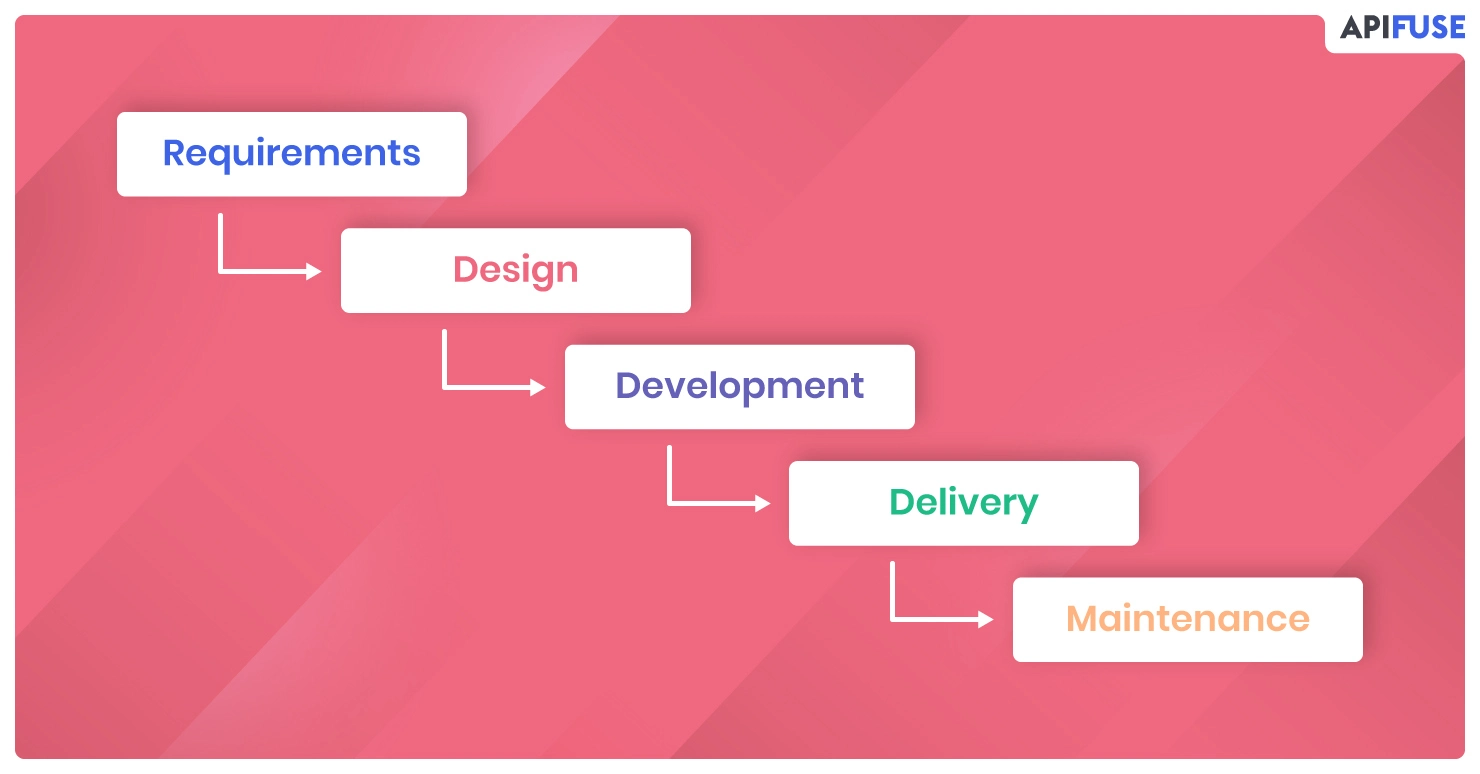
Waterfall has many benefits, such as:
- Clear project structure
- Fixed costs
- Simplified progress tracking
- A repeatable process
Here’s where it falls short.
- The team must complete each phase before moving on to the next. This extends the development cycle – if you need to change something, you need to start over with each phase. This increases costs and leads to delays. That’s why adjusting the project plan mid-process is often not feasible. As a result, a product may no longer meet current market demands or use the latest technology by launch time.
- Typically, you can’t integrate feedback until the end of the process. This long feedback loop can prevent you from iterating quickly.
- Different teams work on their respective phases independently. This separation can lead to communication gaps, misaligned objectives, and a lack of collaboration.
This is why the Agile framework came along – to propose a new approach that will fix these issues.
Let’s explore more tactics you might’ve not heard of.
1. Pretotyping
No, this isn’t a typo 🙂 You’ve heard of prototyping – a design process that creates a mock-up for testing.
Pretotyping takes a step back. It’s about creating simulated versions of products to gather feedback before full development. In other words, pretotyping happens before prototyping.
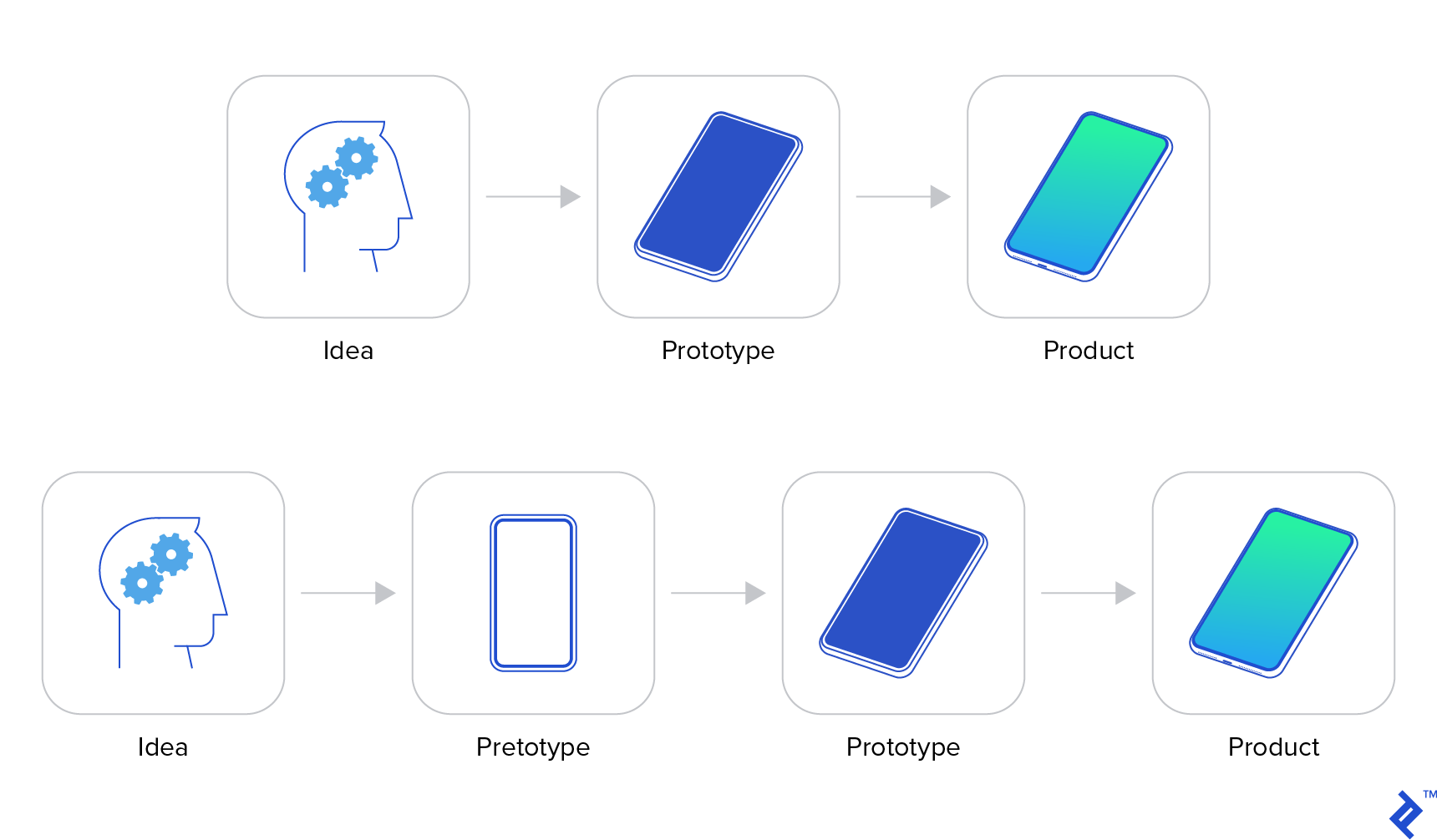
“Pretotyping is a set of tools, techniques, and tactics that help you validate any idea for a new product.”
Alberto Savoia, Google’s first engineering director, author of “The Right It”
How to implement it
Goals:
- Gauge interest before investing in development
- Validate assumptions
- Determine the probability of product success
A pretotype is meant to be a quick experiment. You want to test your ideas with the minimum amount of money, time, and effort. Here’s how you could do it.
- Pick one key assumption.
- Choose a pretotype. Alberto Savoia offers the following options.
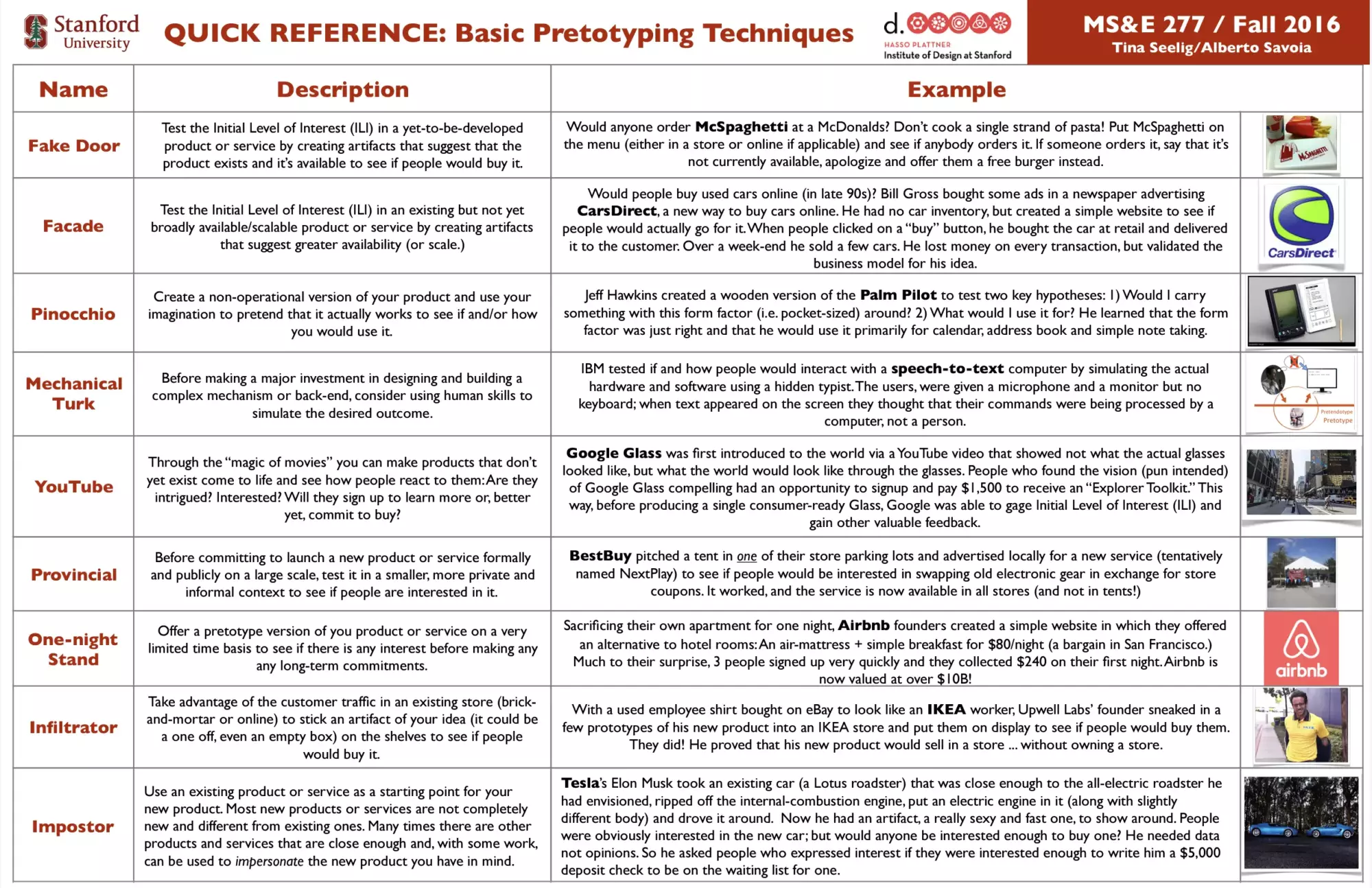
3. Set a market engagement hypothesis. How many (and what kind of) people will do what with your pretotype? For example: X% of Y will do Z
4. Test your pretotype. Put it into the real world, and watch how people interact with it.
5. Learn, refine, hypozoom. Evaluate your results. Refine your pretotype with your new data.
If your hypothesis held, test your pretotype in other situations. Alberto calls it “hypozooming”.
Example: IBM
IBM wanted to test speech-to-text technology. First, they wanted to know if users would even want to use such a tool.
They simulated actual hardware and software using a hidden typist. The testers held a microphone and looked at a monitor, but they didn’t have a keyboard. They spoke into a microphone and watched text appear on the screen. They thought that a computer was typing what they were saying. In reality, it was a person.
IBM saw interest in this tool and started developing it. They also got early product marketing through this test.
2. Lean UX
You’re familiar with both “lean” and “UX” terms, but how do they work together?
Lean user experience (UX) is about integrating UX design throughout the product lifecycle.
“The core objective is to obtain feedback as early as possible and use it to make quick decisions. Agile product management works in rapid, iterative cycles. Lean UX mimics these cycles to use the generated data in each iteration.”
Frank Spillers, CEO/CX, and UX + service design lead the Experience Dynamics
One of the easiest ways to get that early feedback is to build a minimum viable product (MVP). This approach can even follow the pretotyping idea from the previous section. Here’s how:
- You’ve built and tested a pretotype
- You know there’s a legitimate interest in your idea
- Now you can build an MVP
An MVP is a bare-bones version of your product. You include only what’s absolutely necessary and leave out all the rest. This way, you don’t spend time and other resources building something that might not work. An MVP’s purpose is to validate your idea.
“As you consider building your own minimum viable product, let this simple rule suffice. Remove any feature, process, or effort that does not contribute directly to the learning you seek.”
Eric Ries, author of “The Lean Startup“
An MVP helps you gather quick and actionable feedback. You can use that feedback as you continue perfecting your product. Feedback helps you stay focused on your customer and their experience (UX). When you put user experience at the center of your product development, you apply the Lean UX method.
Most product managers think of MVP (Minimum Viable Product) as:
— JustAnotherPM | Sid (@JustAnotherPM) October 16, 2023
"The V1 of the product they want users to use."
That is 100% WRONG.
In Product Management, a few concepts (like MVP) are frequently used, yet grossly misunderstood.
MVP as a concept has revolutionized the way…
How to implement it: think, make, check
To test out lean UX yourself, follow these main steps.
1. Think. Brainstorm potential areas for improvement. Use existing customer feedback, research, and more. Then, set a hypothesis.
Example: reducing the number of steps in the onboarding process will improve user retention.
2. Make. Build an MVP.
Example goal: simplified onboarding experience.
Example steps:
- Reduce required steps from seven to three
- Add a progress indicator to help users understand how far along they are
- Give a skip option for non-essential information
- Include tooltips to guide users through the process
3. Check. Analyze the performance of your MVP. Did it validate your hypothesis? If not, go back to step one.
Example:
- The team tracked user retention, drop-off rates during onboarding, and overall user satisfaction
- Result: 15% increase in user retention and 20% reduction in drop-off rates
The results validated the hypothesis. Based on this, the team permanently implemented the new onboarding process.
Example: Dropbox
Dropbox is a cloud solution for file sharing and syncing. Here’s how they applied the Lean UX model.
- Think. When the Dropbox team was first building the tool, “the founders wanted feedback from customers about what really mattered to them.” Their hypothesis was: “File synchronization is a problem that most people don’t know they had. Once they experience the solution, they won’t be able to imagine how they ever lived without it.”
- Make. Dropbox’s MVP was a simple demo video that showcased the core functionality. This video gauged interest and collected user feedback before full development. This low-cost approach validated the demand for such a service.
3. Check.
“[The MVP video] drove hundreds of thousands of people to the website. Our beta waiting list went from 5,000 people to 75,000 people literally overnight. It totally blew us away.”
Drew Houston, CEO of Dropbox
Dropbox achieved incredible product success with the help of Lean UX.
3. Impact mapping
Impact mapping is a collaborative planning technique. It’s based on:
- Outcome-driven planning – first, define the desired results. Then, plan backward to determine which steps will help achieve those outcomes.
- Mind mapping – a visual brainstorming technique that helps organize information. It involves writing down a central idea and branching it into related subtopics.
- User interaction design (IxD) – designing how users interact with a product. The focus is on making the product intuitive and easy to use. IxD includes creating layouts, menus, buttons, and other interactive elements.
Basically, an impact map is a mind map on steroids. It takes your mind map further and adds strategy and IxD to it. This helps you align product development with user and business goals.
“Impact mapping is fast, visual, and collaborative. It makes it easy to engage people from various roles and backgrounds. It exposes hidden assumptions and documents important decisions. It provides just enough structure to facilitate effective planning and prioritization. But it doesn’t get in the way with complicated syntax or bureaucracy.”
Gojko Adzic, author of “Impact Mapping“
How to implement it
Gojko separates his impact map into four main parts:
- Your main goal
- Actors (i.e. users)
- Impact (desired action)
- Deliverable (what do I need to do to make the desired action happen)
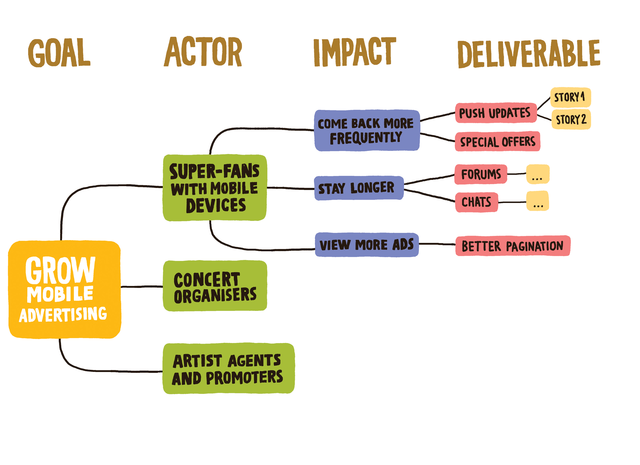
This product strategy combines several popular approaches, and it’s easy to get confused. Tim Herbig, a product management coach, helps clarify the difference between them here.
Learn more about impact mapping in this podcast from Tim Herbig.
Example: Codurance
Codurance is a software consulting company. They used impact mapping to help a client prioritize social media platform features. This client had a large product backlog and roadmap but lacked prioritization clarity. Here’s how they created an impact map to fix this problem.
- Goal: achieve a target number of users for a new social media platform
- Actors:
- Primary users
- Advertisers
- Impact (desired actions)
- Users: increase engagement; encourage users to share content and invite friends
- Advertisers: attract advertisers by demonstrating a growing and engaged user base
- Deliverable
- Users: develop features that simplify and reward content-sharing
- I.e. add a share button, notifications for friend invites, etc.
- Advertisers: create analytics tools to show advertisers user engagement metrics and growth trends.
- Users: develop features that simplify and reward content-sharing
“The client was very happy – they are now clear about each feature. The impact map helps them provide a strong argument if investors ask for features that do not align with original product goals.”
Mashooq Badar, founder of Codurance
4. Opportunity solution tree
An opportunity solution tree is a problem-solving technique. It helps teams evaluate potential solutions to a given opportunity. Similar to impact mapping, it’s a very visual approach.
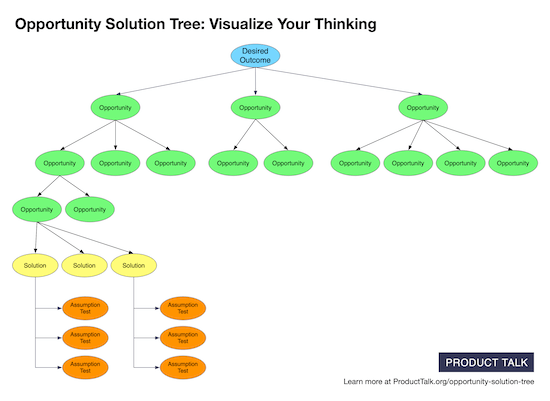
The tree has a few sections:
- The root = desired outcome
- Opportunity space = customer needs, pain points, and desires
- Solution space = potential solutions you’re exploring
- Assumption tests = to evaluate which solutions will best combine customer and business value
Teresa Torres, the author of “Continuous Discovery Habits,” developed this framework.
“We struggle with the distinction between the problem space and the solution space. The heart of a good product is getting comfortable in the problem space (or the opportunity space). It’s about really taking the time to frame a problem well before jumping to solutions.”
Teresa Torres
How to implement it
- Identify the desired outcome. Start with what you want to achieve. What’s your business objective? How can you use this exercise to support it?
- Map out opportunities. Brainstorm all possible ways to achieve that desired outcome. Consider different customer needs, pain points, and market gaps.
- Explore solutions. For each opportunity, list potential solutions. Focus on how these solutions can address the identified opportunities.
- Prioritize and test. Rank the solutions based on potential impact and feasibility. Begin testing the most promising ones and iterate based on results.
Example 1: trivago
Trivago is a hotel comparison website. Their team built an opportunity solution tree to “tailor the search experience and help the user move down the funnel.” Here’s how they implemented this strategic planning framework.
- Identify the desired outcome
- Better understand user intent through both explicit and implicit user signals
- Tailor the search experience
- Guide users down the funnel
- Map out opportunities. Trivago phrased opportunities as user needs they could solve:
- “I need to decide where to stay”
- “I wish it would take less effort to find hotels that meet my preferences”
- “I only want to see hotels that meet my preferences, not all the other irrelevant ones”
- “I need to trust that my preferences are reflected correctly”
3. Explore solutions
- Refine filters
- Showcase relevant hotel details
- Suggest personalized options based on user input
4. Prioritize and test
- Prioritize features that help reach the desired outcome
- Conduct user interviews
- Test assumptions
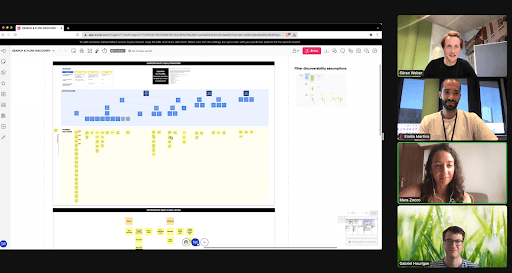
“Product management is no perfect science. With the opportunity solution tree you can make sense of it and give it structure only to a point. It helped us get buy-in from the UX research team and the product leadership to embark on the continuous discovery journey.”
Sören Weber, senior AI product manager at Trivago
Example 2: Wrike
Wrike is a project management tool that helps businesses simplify their workflows. Elisa Montanari is the head of organic growth and website strategy. She shared her experience with this technique.
“[The] Opportunity Solution Tree helped me prioritize at a high level and kept our strategy focused. But when it came to the nitty-gritty daily tasks, it wasn’t as effective. Some of my colleagues found it hard to adopt for everyday use.”
Elisa Montanari
Elisa manages a Scrum development team of 8 and an SEO team of 3. Her insights bring up an important point: focusing on one particular framework shouldn’t be the goal.
“This experience taught me something important: it’s not about the framework itself. It’s about fixing the right problems in our process.”
Elisa Montanari
It’s also OK to try something, see that it doesn’t work, and move on.
5. Innovation games
Innovation can help your product stand out and succeed.
“The toughest part of innovation? Accurately predicting what customers want, need, and will pay for.”
Luke Hohmann, CIO at Applied Frameworks, author of Innovation Games
Luke Hohmann came up with a concept called innovation games. They are:
- A form of primary market research
- Structured activities to foster creativity and collaboration
- Designed to help you uncover your customers’ true, hidden needs and desires
Typically, you’d gather existing or potential customers to play these innovation games. However, you might not have the resources or enough existing customers. Then, you can play these games internally – with your team. Your results will be different because your team knows your product and isn’t always the target customer. Still, you can test these games with them and assess the results. Later, you can repeat the experiment with real users and compare the results.
You need a facilitator for each game. Ideally, a product manager or product owner from your team facilitates them.
Here’s a quick description of each innovation game.
- 20/20 vision. The facilitator writes down potential features on Q-cards and tapes one to a wall. Then, the facilitator shows the feature cards one by one. Participants decide if each is more or less important than the one on the wall. No ties allowed!
- Buy a feature. Participants use a set budget to “buy” features from a list. They can pool resources to afford more expensive features. This will force them to prioritize what they value most.
- Give them a hot tub. Mix in wild, unexpected features with normal ones to see customer reactions. This helps understand what surprises or delights users and what they truly want.
- Me and my shadow. Observers closely follow a user interacting with a product. They note actions and ask why users do certain things. This reveals hidden usability issues and user thoughts.
- Product box. Teams create a mock product box with crafts, imagining they’re marketing it at a tradeshow. This helps identify what users find most appealing or essential about the product.
- Prune the product tree. Draw a tree where branches represent different product features. Participants add “leaves” (new feature ideas), showing which areas they think need growth. Then, you collectively “prune” the product tree. The goal is to leave only the most impactful feature ideas.
- Remember the future. Participants envision a future where they’ve used the product extensively. Then, they describe how it made them successful or happy. This reveals aspirational goals and desired features.
- Show and tell. Users bring in examples of how they’ve used the product. They explain why these uses are important to them. This highlights real-world applications and user priorities.
- Speed boat. Draw a boat with anchors, symbolizing features that slow it down. Participants label these anchors with disliked features, prioritizing which issues to fix first.
- Spider web. Place your product in the center of the spider web. Ask participants to add competing products around it. Then, visually show how these products are related. For example, use a solid line for complementary products and a dashed line for direct competitors. This helps you visualize the competitive landscape.
- Start your day. Participants outline their daily routine using the product, highlighting helpful and frustrating moments. This helps identify pain points and opportunities for improvement.
- The apprentice. Developers use the product as real customers, experiencing its strengths and flaws firsthand. This hands-on approach helps identify usability issues and areas for enhancement.
How to implement it
In his book, Luke proposes 12 different games. You don’t need to try all 12, though! Here’s a helpful graphic that separates these games based on your focus area. For example, if you’re interested in learning more about your users’ needs, you can try “Me and My Shadow,” “Show and Tell,” or “The Apprentice.”

If you’re still unsure which ones to choose and how to facilitate them, follow these key steps.
- Define objectives. Set clear goals for what you want to achieve – enhancing creativity, improving problem-solving, etc.
- Consider time limits. Choose games within your available timeframe to ensure full participation and engagement.
- Accommodate diverse preferences. Select games that cater to different learning styles and preferences (i.e., visual or hands-on activities).
- Align with team goals. Pick games that are relevant to your team’s projects or real-world scenarios.
- Rotate and refresh. Introduce new games if you feel you’re not getting the desired results.
- Use technology. Incorporate digital tools and platforms for virtual or tech-enhanced game experiences. For example, Lucidspark offers free templates for the Buy a Feature game.
- Monitor engagement. Observe and assess engagement levels to ensure the games are effective and enjoyable.
- Gather feedback. After each session, collect feedback from participants to refine future game choices. A tool like Canny can help you with this.
Example: Ford Motor Company
Liz Schemanski is a former UX Designer at Ford Motor Company. During her time there, she inspired her team to use the “Buy a Feature” innovation game.
Goal: identify which features users valued most and were willing to pay for. Their process looked like this:
- Familiarizing participants. Users explored five potential features through scenarios and tasks. Those features weren’t fully built yet.
“We already had some basic screens in a prototype that would show each of our feature concepts. They didn’t need to be perfect; they just needed to show the potential and possibilities of each feature.”
Liz Schemanski
Here’s one scenario Liz’s team used during this experiment.
“As you were driving here today, you noticed your check engine light come on on the dashboard. You kept driving and arrived at our appointment. But you just saw this [show prototype push notification] on your phone. Show us what you would do from here.”
- Shopping phase. Participants received a set amount of “monies” to spend on the features. The features were not labeled, which allowed users to choose features based on their preferences without bias. The goal is to pick the features they find the most valuable.
“Each tool was priced equally. [That’s because] our main goal was not to find out which feature we should build first based on complexity. Rather, it was to understand which features the participants valued most without being influenced by the cost to build.”
Liz Schemanski
- Feedback collection. After making their selections, participants explained their choices, revealing their preferences and reasons. This provided valuable insights into user needs and priorities.
“Some sample questions we asked included:
• Why did you put down the full ten monies for this?
• Why did you put down equal monies for these two tools?
• Why did you pay six monies for this tool and two monies for that tool?
• Why did you not buy this tool?”
Liz Schemanski
This approach helped gather qualitative data on user preferences without building full-fledged prototypes. Buy a Feature proved to be a cost-effective method for early-stage product development.
6. Platform thinking
Platform thinking is “product thinking applied to digital platforms.” What’s product thinking? It’s a mindset that prioritizes the user when designing solutions.
This approach connects your target market and the developers of your product. A “platform” lets them interact and create value together.
- A developer builds a product and envisions how users will interact with it
- Users join the platform
- They add value by creating content (Facebook), selling products (Etsy), providing services (Lyft), and more
- The platform becomes better thanks to its users
- Developers watch these interactions and improve the product based on them
Instead of just selling a product, you build a platform that facilitates these interactions. This helps your product grow and become more valuable. The more people use and contribute to it, the better it becomes.
“It moves beyond traditional linear business models. Those rely on a straightforward supply chain from production to consumption. Instead, platforms facilitate interactions between multiple interdependent sets of customers. This creates value through network effects.”
Dan Pontefract, founder of Pontefract Group
Many successful products use the platform thinking approach. Common examples include Amazon, Uber, Netflix, Spotify, and others.
How to implement it
Follow these steps to adopt platform thinking.
- Identify what you offer. Start by figuring out the unique value your platform can provide that others can’t. Understand your customers’ needs and how your platform can meet them. Find your product differentiation.
- Create a strong foundation. Build a core feature that everything else revolves around. This could be a marketplace, a set of tools, or a service hub that others can build on.
- Encourage user interactions. Make it easy for different groups to interact on your platform. For example, eBay benefits from both buyers and sellers actively engaging.
- Partner up. Work with other companies, developers, and partners to expand your platform’s capabilities. This means inviting others to create apps, services, or products that complement your core offering.
- Grow gradually. Start small and gradually add more features based on user feedback. This lets you quickly adapt to changes and continuously improve.
- Set clear rules. Establish guidelines for how people can use your platform. Explain how you handle data and manage interactions. This helps maintain trust and smooth operations.
Example: Glassdoor
Glassdoor could’ve been just another job search site. Instead, they became a platform for real and honest company reviews, salary data, interview insights, and more. They are a true example of platform thinking. Without reviews from users, Glassdoor wouldn’t be as valuable.
- What they offer. Glassdoor’s unique value: workplace transparency. They empower employees to share honest reviews. Users can submit comments about their employers, company culture, the CEO, and salaries. You can’t find this information anywhere else on the web.
- Their strong foundation. Glassdoor’s core: a comprehensive database of employee reviews and ratings. This foundation supports additional tools and services. Detailed company profiles, salary comparisons, and interview preparation resources are some examples.
- Encouraging user interactions. Users can view some information at first, but eventually need to submit their own reviews to keep browsing. This helps Glassdoor grow and increase their value.
- Partnering up. Glassdoor collaborates with recruitment agencies and organizations. They offer access to valuable data for detailed analysis and reporting. Businesses can also get enhanced profiles (paid service). This allows them to customize their Glassdoor profiles. They can showcase job listings and highlight why they are great places to work. This approach expands Glassdoor’s platform capabilities and provides additional value to its users.
- Growing gradually. Glassdoor initially focused on company reviews and gradually expanded its services. They got proof of concept first and grew later.
- Set clear rules. Glassdoor established clear guidelines for content submission. The goal was to ensure the accuracy and reliability of reviews. They maintain strict policies for data handling and user interactions. This helps build and maintain trust among users and companies.
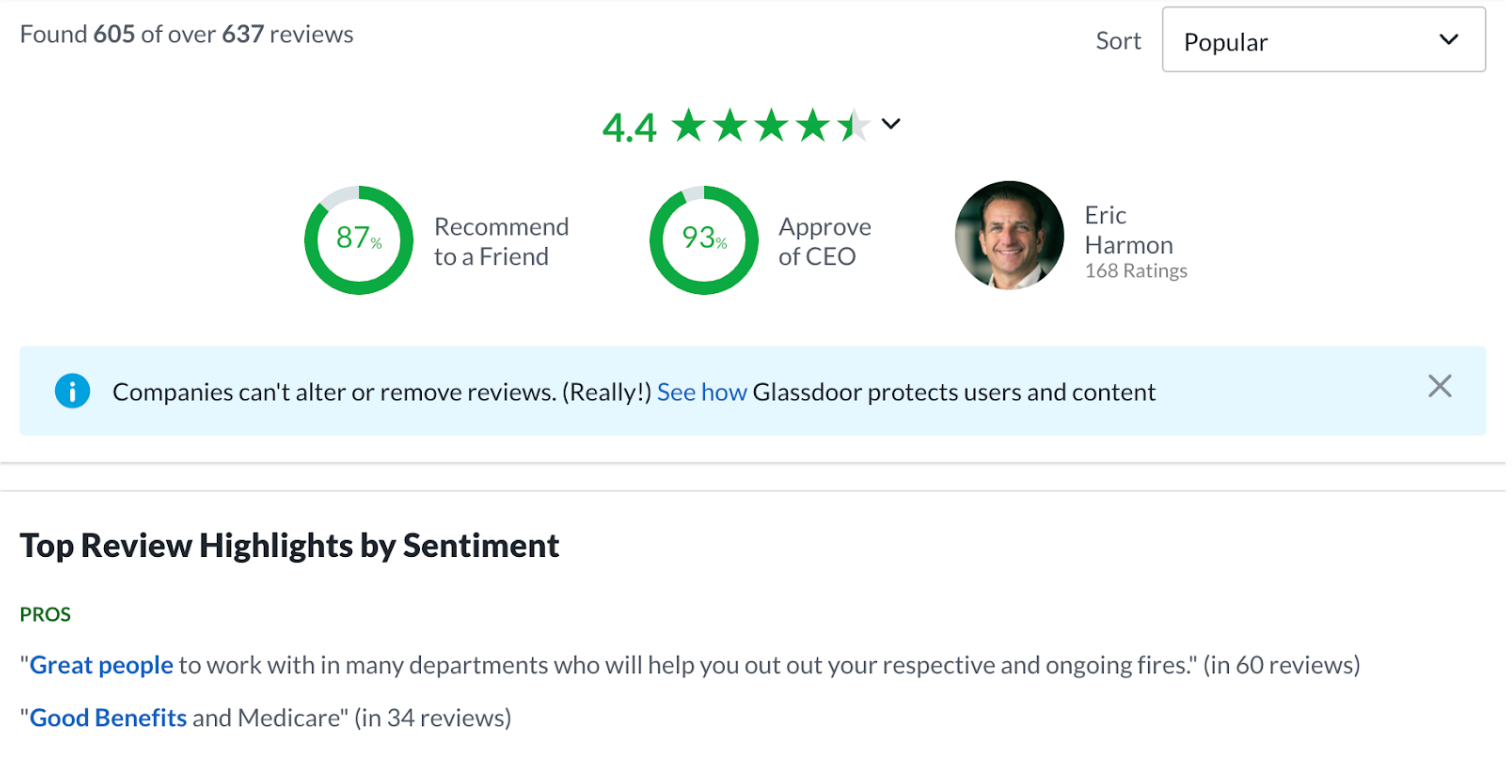
7. The 10x rule
Larry Page, Ken Norton, and Grant Cardone advocate for this strategy. The 10x rule encourages a product leader to build tools that are ten times better than the competition.
Larry Page calls this aiming for “moonshots” or 10x improvements rather than incremental changes. He believes that aiming for significant breakthroughs leads to more innovative thinking. As a result, companies achieve more.
“It’s natural for people to want to work on things that they know aren’t going to fail. But incremental improvement is guaranteed to be obsolete over time. Especially in technology, where you know there’s going to be non-incremental change.
So, a big part of my job is to get people focused on things that are not just incremental. Take Gmail. When we released it, we were a search company. It was a leap for us to put out an email product, let alone one that gave users 100 times as much storage as they could get anywhere else. That is not something that would have happened naturally if we had been focusing on incremental improvements.”
Larry Page
This ambitious strategy might seem reserved only for large companies. Or it might seem like you need big visionaries like Larry Page to use this approach. But it’s not the case.
“Not everyone is aiming to land on the moon, and not everyone works for Google or SpaceX. That doesn’t mean you can’t use moonshot thinking. If you set crazy ambitious goals and miss them, you’ve probably still achieved something remarkable.”
Ken Norton, executive coach to product leaders, former director of product management at Google
Canny’s founders entered the product management market when there were already existing players. Andrew and Sarah had to capitalize on product differentiation. Canny had to be 10 times better than the competition.
“To create a successful business in software, to convince people to use your software instead of what’s already out there, it needs to be way better in some aspect. Ideally, 10x better. Otherwise, why would people switch?
This ties well with our product-led growth strategy. If we want to be a “dominant” solution, our product needs to be much better and offer a lower price point.”
Andrew Rasmussen, co-founder of Canny
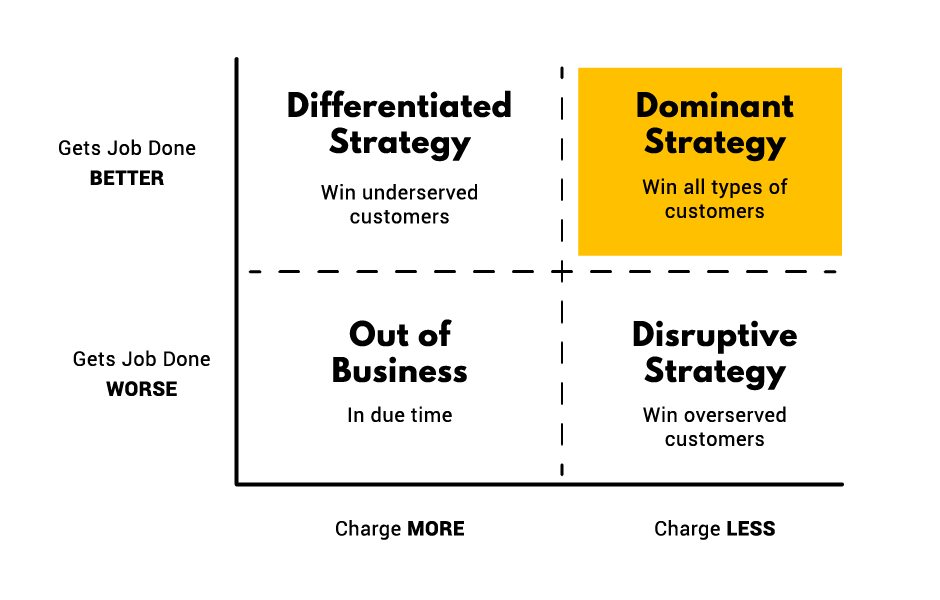
How to implement it
Here’s how Ken Norton recommends applying the 10x rule.
- Set ambitious goals. To drive significant innovation, focus on making products or processes 10 times better rather than just 10% better.
- Encourage risk-taking. Create a culture where experimentation and failure become opportunities to learn and improve.
“If you aren’t experiencing failure, then you are making a far worse mistake: you are being driven by the desire to avoid it.”
Ed Catmull, former president of Pixar
- Use data to drive decisions. Base strategies on data and evidence rather than opinions to validate bold ideas and guide decision-making.
- Promote a learning culture. Emphasize continuous learning and rapid iteration to foster innovation.
- Bet on big trends. Align innovation efforts with emerging trends to maximize impact.
Example: Amazon
1. Set ambitious goals. Amazon aimed to be “the everything store.” They were successful at selling books, but they had a bigger product vision. Amazon set out to revolutionize the shopping experience. They achieved it by providing unparalleled selection, convenience, and competitive pricing.
2. Encourage risk-taking. They could’ve just focused on expanding their book selection. But this would be 10%-thinking. 10x-thinking pushed them to add completely different categories. In addition, they focused on ecommerce, introduced Amazon Prime, and more.
3. Use data to drive decisions. Amazon analyzes customer behavior, optimizes their supply chain, and personalizes the shopping experience.
4. Promote a learning culture. Amazon encourages their product team to test new concepts, iterate, and learn from failures. This is evident in their product development process.
5. Bet on big trends. Amazon identified and invested in major trends like cloud computing (AWS), digital media, and ecommerce.
Conclusion: explore these innovative strategies
The product management process, especially in SaaS, is bound to evolve. Try some of these tactics if you’re ready for something new. You never know where your next breakthrough will come from. If your current product strategy isn’t working, try these ideas. They could be just what you need.
Note: take each method with a grain of salt. Just because it worked for someone else doesn’t mean it will drive the same results for you. Adjust each technique for your unique company and customers. Effective product management is about adapting existing approaches to your specific situation.
You can also combine some of these product management strategies. Who knows – maybe you’ll develop the next revolutionary framework for managing products. Or, at the very least, you’ll build a successful product.


